
 |
Home | Gasherbrum I Main | Contact |
Updated: October 2011. Click on an image to see the FULL size with a caption.
The following reference information is included:
My rating scale:
 Excellent ;
Excellent ;
 Very Good ;
Very Good ;
 Good ;
Good ;
 Fair ;
Fair ;
 Poor.
Poor.
Please see K2 Trekking Guidebooks.
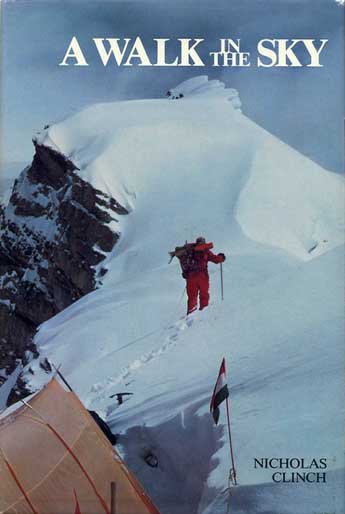

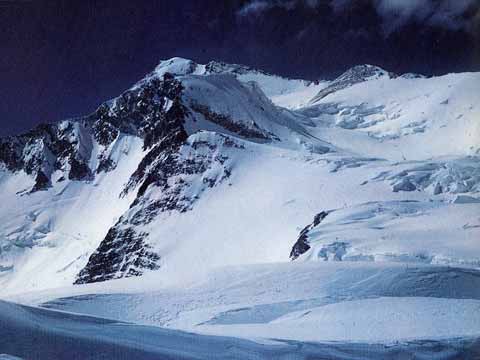
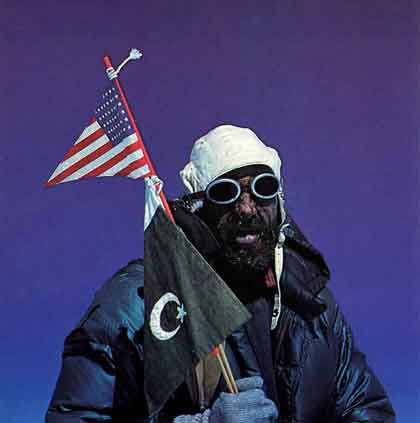

by Nicholas Clinch. First published 1982, but written in 1959. One of Michael Chessler's Top 100 Mountaineering Books. The American expedition leader tells the story of the first ascent of Gasherbrum I (Hidden Peak), with Pete Schoening and Andy Kauffman reaching the summit on July 5, 1958. There are 16 pages of colour photos, 3 pages of b/w photos, 30 b/w photos in-line with text, and a 2-page map. The cover is Nick Clinch leaving Camp III on Gasherbrum I (Hidden Peak).
Clinch thought of the idea of Americans attempting an unclimbed 8000er, sold the idea, persuaded other mountaineers to join the team, and got the expedition off the ground. He helped raise the money, selected the team, and worked on the equipment. He researched the route options and met Andre Roch to discuss the southwest ridge that Roch and Hans Ertl had tried in 1934.
The team flew to Skardu and trekked to Base Camp wearing 10-gallon cowboy hats, Clinch's idea to help create a team atmosphere. "Exuberant because the last human habitation was behind us, Schoening and I began to sing. Immediately the porters joined in. ... With the departure of the porters the last of the unfamiliar uncertainties were behind us. From this point on we would be doing what we had done for years - climbing a mountain." They investigated the northwest ridge, but decided on the southwest Roch ridge. They fixed ropes to the southeast snow plateau that led between up the plateau between Hidden South and Urdok Peak to the summit pyramid.
In true American democratic fashion they voted for the summit team. "Neither Schoening nor Kauffman had voted for themselves, but everyone else had. They were to be the summit team." Nevison, Swift and Clinch helped set up Camp V. Pete Schoening: "At three o’clock we topped the rounding ridge and there was no place higher to go. We had reached the summit of Hidden Peak, the terminus of months of planning, teamwork, and constant effort. It was exhilarating and beautiful." Andy Kauffman: "Pete Schoening climbed this mountain. Pete broke trail over two-thirds of the way."
I enjoyed reading this book about friends climbing a mountain in true American democratic fashion. Clinch uses conversation to provide insights into personalities and to give the story immediacy. The photos are excellent. I especially liked the idea of the cowboy hats to give the team a distinct identity. The long march to Base Camp was well described.

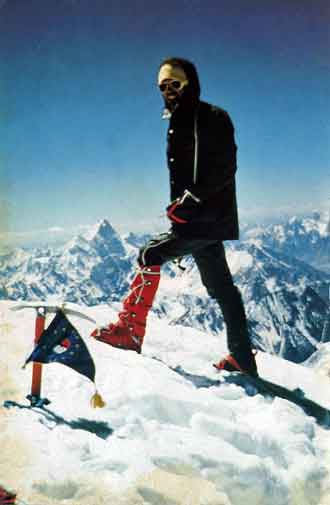


by Reinhold Messner. Published in English in 1977. The book describes Messner's 1975 attempt on the Lhotse South Face and his successful ascent of Gasherbrum I (Hidden Peak) on August 10, 1975 with Peter Habeler. Lhotse has 7 pages of colour photos, 1 page bw photo, 8 bw photos in line with text, 1 map, and 1 climbing route. Gasherbrum I has 9 pages of colour photos, 6 pages of bw photos, 13 bw photos in line with text, and 1 map.
Reinhold Messner and Peter Habeler climbed Gasherbrum I (Hidden Peak) on August 10, 1975 via the difficult North Face without oxygen, fixed ropes, high camps or high-altitude porters. This was the smallest team to succeed on an 8000m peak, and was the birth of Alpine Style mountaineering in the Himalaya.
After several days of waiting in Rawalpindi, they finally get a flight to Skardu where they buy provisions, and continue by jeep to Dassu. They then trek to Askole and Paiju and along the Baltoro Glacier to Base Camp. "The setting sun bathed the Northwest Face of Hidden Peak in a warm glow. All its ribs stood out in sharp contrast, all of its concavities equally clear."
"How insignificant and solitary are two men alone on an eight-thousander! ... We sat at the apex of endless space. Far below in the valleys lay a milky mist. The horizon around spread like the emptiness within. With serene unconcern, I awoke from my state of bliss, from a kind of Nirvana." The weather deteriorated and the descent became more difficult than the ascent.
Messner's writing is interesting and poetic. He describes his feelings and inner-most thoughts, his longing for his wife but also passion for mountain climbing. The photos are very good.
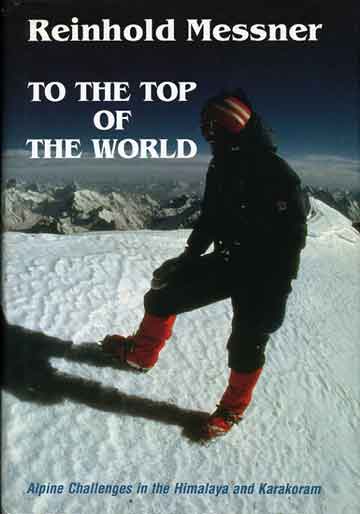
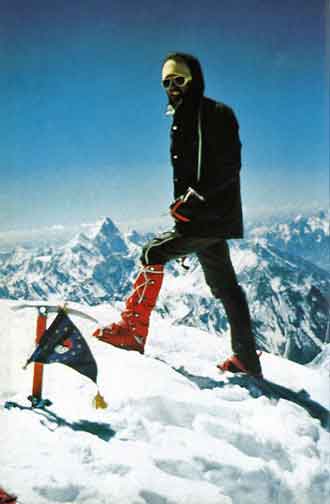



by Reinhold Messner. First published in English in 1992. The book briefly describes Messner's ascents of Manaslu in 1972, Gasherbrum I - Hidden Peak in 1975, Everest without oxygen in 1978 and solo in 1980, Nanga Parbat solo in 1978, K2 in 1979, and a traverse of Gasherbrum I and II in 1984. The cover is the summit of K2. There are 56 pages of colour photos, 20 pages of b/w photos, 26 b/w photos, and six paintings by French artist Jean-George Inca highlighting the stories in the book.
Reinhold Messner and Peter Habeler climbed Gasherbrum I (Hidden Peak) on August 10, 1975 via the difficult North Face without oxygen, fixed ropes, high camps or high-altitude porters. This was the smallest team to succeed on an 8000m peak, and was the birth of Alpine Style mountaineering in the Himalaya. The chapter on Gasherbrum I is 48 pages long with 8 pages of colour photos, 2 pages of b/w photos, 1 b/w photo in line with text, 1 climbing route, and a 1-page painting by Inca.
"Only with difficulty could Peter hold back his tears of joy. ... We sat on the summit, in the centre of an endless, empty space. Far below in the valleys lay milky vapour. The horizon around me grew like the emptiness in me. Any my deep breaths condensed to spontaneous events in a purely visionary circle. With an indescribable feeling of serene indifference I awoke from this state of tranquility, as from a sort of nirvana." The weather deteriorated and the descent became more difficult than the ascent.
Reinhold Messner and Hans Kammerlander reached the summit of Gasherbrum II on June 25, 1984, and then traversed to Gasherbrum I, reaching the summit on June 28, 1984. The chapter on the Gasherbrum Traverse is 13 pages long with 8 pages of colour photos, 1 page of b/w photos, 8 b/w photos in line with text, and a 1-page painting by Inca.
"In three days in radiant weather we were on the summit of Gasherbrum II. ... The next morning we risked the dangerous descent into the Gasherbrum Valley ... Only if we forced ourselves – exhausted, emaciated and without back-up – to venture the second peak, could we succeed in what no one had previously attempted – the combined traverse of two of the highest mountains in the world without rest and without outside help. ... Suddenly it became uncannily gloomy. The storm increased to hurricane force ... Our goggles were iced up, our faces numb. ... At last, behind a cornice was the summit! The second eight-thousander within four days."
If you want a Best Of Messner book, this is a great choice. The photos are excellent. The translation of the 1975 Gasherbrum I ascent is not as good as the original in The Challenge book; it's less poetic and a bit awkward. Messner's writing is interesting and poetic, letting us know his feelings and inner-most thoughts.


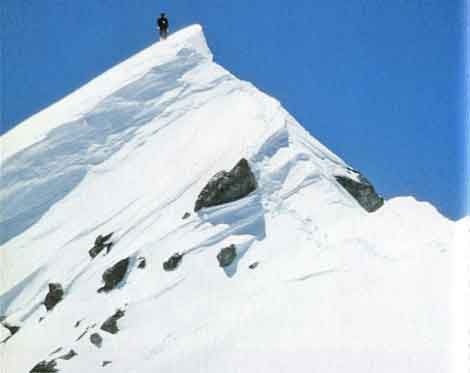

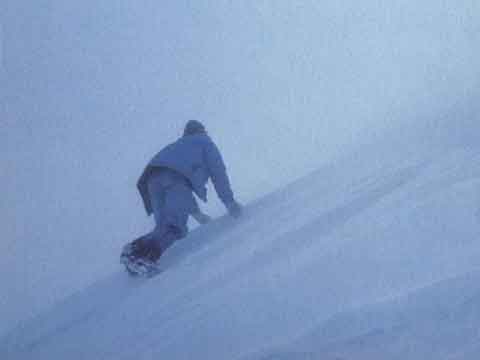

by Reinhold Messner. Published 1998. In German. There are 32 pages of colour photos, 4 pages of b/w photos, 33 b/w photos in-line with text, 9 routes, and 1 map.
The first section (47 pages) describes Messner's 1975 attempt on the Lhotse South Face. There are 4 pages of colour photos, 4 b/w photos in-line with text, and 1 route. The story is from Messner's book The Challenge except the first part of the story is skipped. Some of the photos are the same as The Challenge.
The second section (85 pages) describes Messner's ascent of Gasherbrum I with Peter Habeler on August 10, 1975 via the Northwest Face. There are 11 pages of colour photos, 1 page b/w photo, 18 b/w photos in-line with text, 1 route, and 1 map. The story is from Messner's book The Challenge except the first part of the story is skipped. Many of the photos are different from The Challenge.
The third section (13 pages) describes Messner's ascent of Gasherbrum II with Sher khan and Nazir Sabir on July 24, 1982 via the Southwest Ridge. There are 5 pages of colour photos, 1 page b/w photo, 7 b/w photos in-line with text.
The fourth section (28 pages) describes Messner's traverse of Gasherbrum II (June 25 1984) and Gasherbrum I (June 28 1984) with Hans Kammerlander. There are 9 pages of colour photos, 2 pages of b/w photos, 4 b/w photos in-line with text, and 1 route.
The book closes with 6 b/w routes showing the different ascent routes on Gasherbrum I and Gasherbrum II and who climbed them first.
If you can't read German, it's better to buy either The Challenge or To The Top Of The World. The photos are very good.
My favourite books that partially feature Gasherbrum I are:
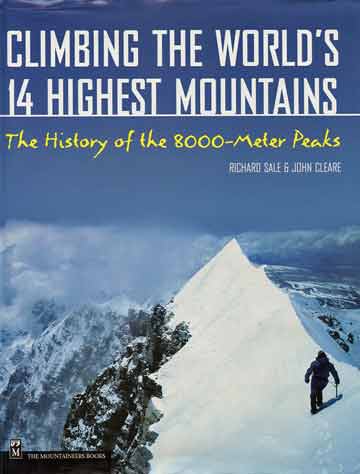



by Richard Sale, John Cleare (Photographer) - Highly recommended! The book details the exploration, first ascent, and other major ascents of all 14 8000m peaks, including spectacular photos. The front cover is Shishapangma.





by Simone Moro. Published 2008. In Italian and English. This coffee-table size book features excellent photos from all 14 8000m peaks. Each 8000m peak has a brief history, a photo of each face showing the climbing routes, and lots of excellent photos.
There are 10 pages on Gasherbrum I with especially interesting photos from the Chinese side.
The photos and route diagrams are excellent.
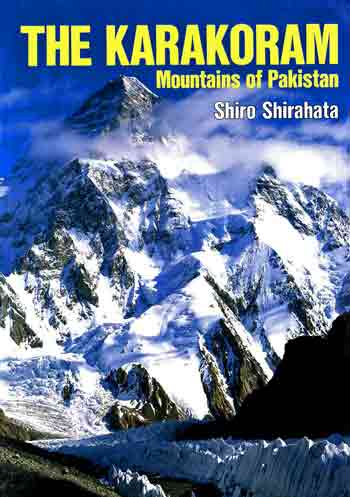


by Shiro Shirahata. Published 1990. One of Michael Chessler's Best Mountain Photo Books. He may just be the best mountaineering photographer ever. This coffee-table sized book provides stunning large photographs printed on glossy quality paper.
This book contains K2 (cover), Broad Peak, Gasherbrum I, Gasherbum II, Gasherbrum IV, Chogolisa, Nanga Parbat, and Tirich Mir. The photo of Gasherbrum IV on the back cover is stunning.
The photos are excellent. Shirahata just may be the best mountaineering photographer ever.
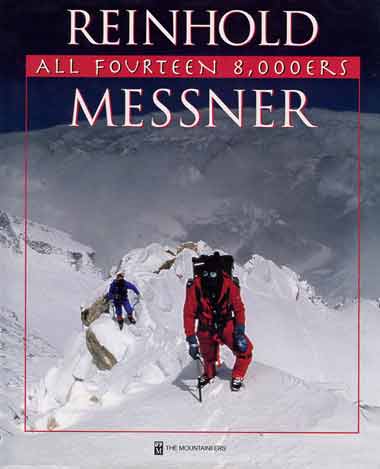
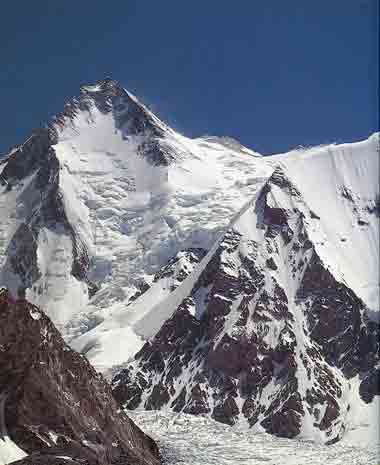
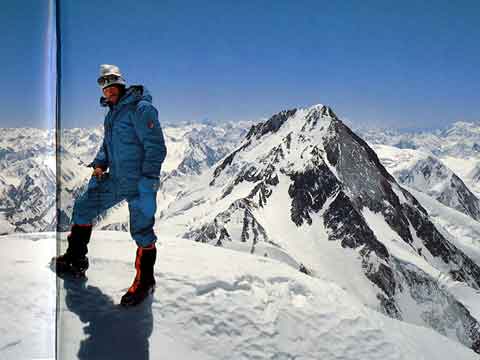
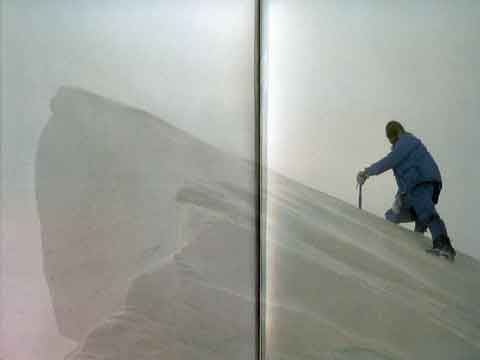

by Reinhold Messner. One of Michael Chessler's Top 100 Mountaineering Books. This book details Messner's ascents of all 14 8000m peaks documented with his photos. He also includes route diagrams and some basic history of the first few ascents. Messner was the first climber to summit all 14 mountains over 8000 metres in height, beginning with Nanga Parbat on June 27, 1970 and finishing with Lhotse on October 16, 1986.
As a 2-man expedition, employing 12 porters as far as base camp only, Reinhold Messner and Peter Habeler reached the summit of Gasherbrum I on August 1, 1975, climbing via its North Face. The ascent was made in classic Alpine style and without the use of artificial oxygen.
From June 23 to 30, 1984, Reinhold Messner and Hans Kammerlander traversed Gasherbrum II and Gasherbrum I in alpine style, reaching the summit of Gasherbrum II on June 25, descending to a pass, and reaching the summit of Gasherbrum I on June 28.
The photos are very good.

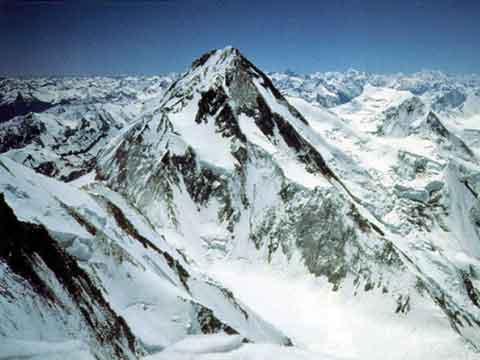

by Andy Fanshawe, Stephen Venables. Published 1996. This book briefly details 40 of the world's finest climbs on mountains in Pakistan (including K2, Broad Peak, Gasherbrum I, Gasherbrum IV, and Nanga Parbat), India, Nepal and Tibet (including Annapurna, Shishapangma, Cho Oyu, Everest, Makalu and Kangchenjunga). Each climb is illustrated with many great photos, climbing routes, and summary statistics and information. Each area has an excellent overview map.
There are three pages on Gasherbrum I Northwest Face.
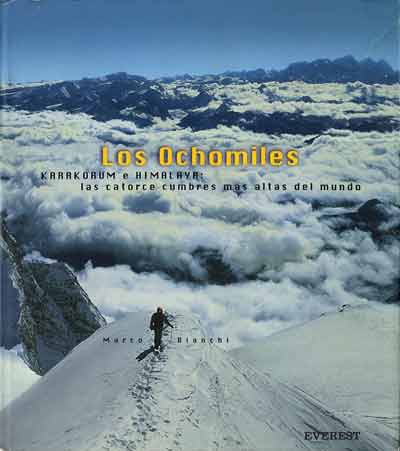


by Marco Bianchi. Published 2003. Although the title claims to be the 14 highest summits in the world, this beautiful, large-format photo book really focuses on the seven mountains the author climbed. The text is in Spanish, but the photos transcend language.
After attempts on Makalu in 1986 and Cho Oyu in 1989, Bianchi summitted seven of the 14 8000m peaks: Manaslu Sept. 28 1992 via Northeast Face, Broad Peak July 6 1993 via Normal route, Cho Oyu Sept. 18 1993 via West Ridge, Shishapangma Oct. 6 1993 via Southwest Face, Dhaulagiri Sept. 25 1994 via Northeast Ridge, Everest May 12 1995 via Northeast Ridge, and K2 Aug. 10 1996 via North Ridge.
There are 44 pages of the trip from Islamabad to Skardu, the trek up the Baltoro Glacier to Concordia, Gasherbrum I and II, Broad Peak and K2.
The photos are excellent.



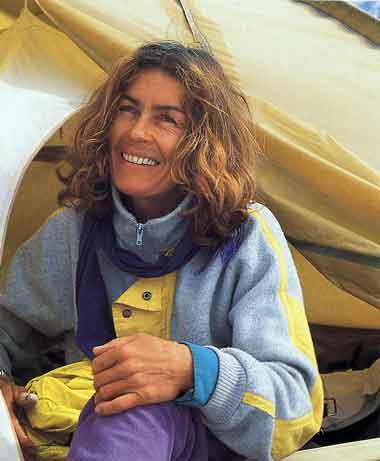

by Gertrude Reinisch. Published in English in 2000. This book traces the career of Polish climber Wanda Rutkiewicz. It includes brief reports of Trollryggen in Norway in 1968, Pik Lenin 1970, the Eiger North Face 1973, the Matterhorn North Face 1978, Aconcagua South Face 1985, and Cerro Torre 1988. The book focuses mainly on her climbs in the Himalaya and Karakoram, including: the first ascent of the then highest unclimbed peak 7952m Gasherbrum III August 11, 1975 (4 pages); Mount Everest summit October 16, 1978 (10 pages); Nanga Parbat attempt 1976 and summit July 15, 1985 (5 pages); K2 expedition leader 1982, attempt 1984, and becoming the first female to summit K2 June 23, 1986 (35 pages); Makalu attempts 1986 and 1990 (10 pages); Shishapangma Main Summit September 18, 1987 (4 pages); Gasherbrum II summit July 12, 1989 (14 pages); Gasherbrum I summit July 16, 1990 (19 pages); Cho Oyu summit September 26, 1991 solo (2 pages); Annapurna winter attempt 1987 and south face summit October 22, 1991 solo (15 pages); Dhaulagiri aborted attempt 1991 (3 pages); Yalung Kang (8505m) winter 1988/89 attempt, and Kangchenjunga attempts in 1991 and 1992 (24 pages); Wanda Rutkiewicz died May 12 or 13, 1992 on Kangchenjunga. There are transcripts of many of her personal letters from expeditions across the world. There are many photos.
Wanda invited the author to go with her to Gasherbrum I Hidden Peak in 1990. 'It was on this expedition that I got to know Wanda better and got to know another side of her. On the mountain she was fanatical, entirely directed to her one goal, incapable of evaluating or even considering suggestions from others. ... She lacked any insight into her fellow-climbers and constantly misjudged both their personalities and their climbing abilities. ... Wanda thought for herself, not for others.' After reaching 6600m on Gasherbrum I, the author switched to attempt Gasherbrum II while Wanda and Ewa Pankiewicz continued on Gasherbrum I. Wanda: 'I always feel unsettled before a climb, racked by doubts whether I can achieve what I have set myself. But once I've started an ascent my concentration drives out all fear; my mind empties of all thought or feeling that isn't essential to the mountain.'
It was 2 a.m. on July 16 when Wanda, Ewa and the Koreans left Camp III (7100m) for the final assault. Wanda: '16 July 1990 was Ewa's day. It was astonishing to watch this midget of a woman fighting her way through the deep snow to the summit far ahead of me and the Korean. Ewa was not only breaking trail, but still managing to move much too quickly for Wanda to catch up. Just below the summit they faced a final peril in the shape of a steep ice slope which should have called for two axes where they only had one between them. 'Suddenly there was nowhere to go. Ewa had to wait half an hour for me in a snowdrift, and we could see nothing at all from the summit. But it was Ewa's first 8000m peak!' The falling snow was increasing the dangers of descent, and they were forced to spend the night in the Korean's bivouac bag, but without sleeping bags, perched on a tiny sloping platform. They descended to their supplies at Camp II (6300) the next day.
The book is written in a straightforward manner, factual and to the point. We do get some insights into Wanda as a person through her relationship with the author and her letters. The photos are very good.
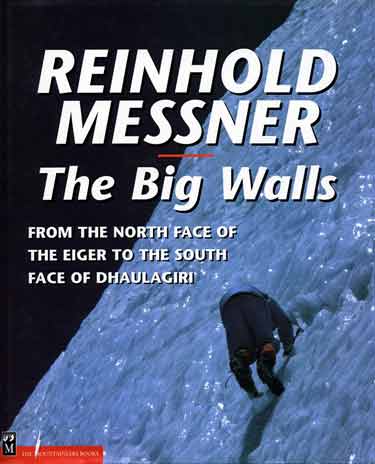


by Reinhold Messner. Revised in 2001. Messner briefly details the big mountain walls in the world in the Himalayas, the Karakorum, the Alps, South America, Alaska and the Caucasus.
It includes 2 pages on the Gasherbrum I Southwest Face.
I like this as a reference book. The photos are very good.
In addition to the following DVDs and Videos please see youtube.com Gasherbrum I videos.





Directed by Werner Herzog. Filmed 1984. Released 1985. 45 minutes. Overdubbed in English. Herzog follows Reinhold Messner and Hans Kammerlander as they attempt the first traverse of two 8000m peaks, Gasherbrum II and I. Messner: “Nothing like this has ever been tried before. We’ve got no points of reference.” Instead of focusing on the climbing, Herzog want to know: “What goes on inside mountain climbers who undertake such extreme endeavours. What is the fascination that drives them up to the peaks like addicts? Aren’t these mountains and peaks like something deep down inside us all?”
Herzog follows the expedition to Skardu where Messner buys supplies and selects the porters. They drive to Dasso and then trek along the Braldu river and up the Baltoro Glacier to Base Camp. Messner is interviewed in a hot spring near Askole, and several times at Base Camp, including a very humourous one with a porter giving him a vigorous massage. Messner mentions that they "climb freestyle. Each of us is responsible for himself." He talks about descending Nanga Parbat in 1970 with his brother Gunther dying and how it changed his life. "I didn’t care if I died or not … when I got home I had this feeling that my life began anew with that tragedy." When Herzog asks him how he broke the news of Gunther's death to their mother, Messner breaks down and sobs.
Messner and Kammerlander than leave for their climb, with Herzog following them with long telephoto scenes of them on the glacier and a slow telephoto pan from the two climbers low on the route, up, up along the route to the summit, clearly showing the length and scale of their climb. Messner uses a small movie camera to film Hans Kammerlander arriving on the summit of Gasherbrum II on June 25, 1984, the view from Gasherbrum II, and their climb in bad weather to the summit of Gasherbrum I on June 28, 1984. They finally cross the glacier and arrive back in Base Camp. Messner is interviewed again as he bathes naked in a glacial pool.
DVD5 of Werner Herzog's Documentaries and Shorts DVD collection also has The great ecstasy of Woodcarver Steiner (1973, 44 minutes), No one will play with me (1976, 14 minutes). and Ballad of the Little Soldier (1984, 44 minutes). Werner Herzog eats his shoe (1980, 21 minutes).
This is an excellent intimate portrait of Reinhold Messner and views on mountain climbing. The mountain scenes are excellent with Messner himself adding the summit views. The scene of the porter giving Messner a vigorous massage is hilarious. The video quality is excellent.




by Sebastian Alvaro. Al Filo De Lo Imposible, Spanish TV. 57 minutes. Released 2005. Karakorum contains three films: a 1997 attempt on the west face of Amin Brakk (5850m) (15 minutes), a 1996 kayak trip down the rapids of the Indus River (15 minutes), and 1996 expeditions to Gasherbrum I and Gasherbrum II (24 minutes). This DVD has one other film, El Territorio del Leopardo, 72 minutes, that shows an attempt to climb Broad Peak in the Winter of 2003.
The Gasherbrum film starts with the trek to base camp, showing somewhat frightening scenes of crossing a river in a basket, doctor Jose Gazo treating porters, arriving at base camp, and crossing glaciers on the way to the Gasherbrums.
Juan Tomas and Iñaki Ochoa de Olza reached the summit of Gasherbrum I on July 10 and safely returned to Base Camp. While Al Filo was following Spanish climbers attempting Gasherbrum II, they were interrupted to try and help Manuel Alvarez Diaz who fell while descending from the summit of Gasherbrum I on July 11, injuring his back, neck, and one eye. He was unable to continue and was lowered by his partner Alfonso Juez to Camp 3, but rescue was impossible due to avalanche hazard. He died on July 17. There is radio communication with Camp 3 and interviews with climbers and the doctor.
The climbing continues on Gasherbrum II with Jose Carlos Tamayo, Ramon Portilla, and Iñaki Ochoa de Olza reaching the summit of Gasherbrum II on July 29, 1996.
The filming is very good, showing the climbing routes, and the story is exciting.